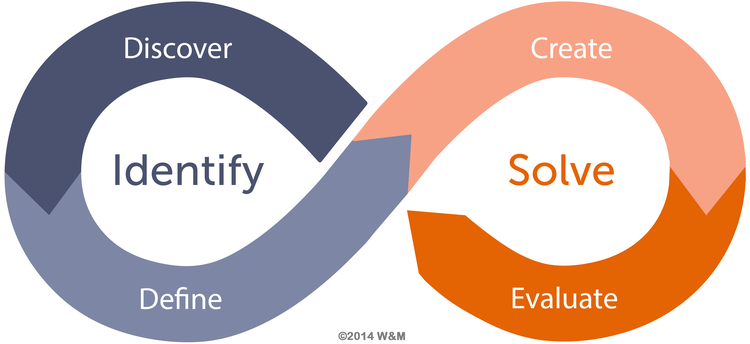SKILLS
- – Opportunity Identification
- – Improvisation
- – Collaboration
- – Failing Wisely
MINDSET
- – Open to Risk
- – Tolerance for Ambiguty
- – Grit
- – Self-Directions
We take a user-centric view of innovation and entrepreneurship at William and Mary. We believe that true innovation and lasting value is created when solutions are developed with the user at the forefront.
Because of this focus, Design Thinking and Customer Development are two related methodologies at the core of our innovation and entrepreneurship offerings.
The general methodology that we teach in our innovation courses is commonly referred to as “Design Thinking”. Design Thinking has emerged as a best-practice set of methods and mindset, wherein traditional analytical skills are merged with creative, divergent thinking skills in an intentionally structured, yet highly flexible and dynamic process. Design Thinking reflects ideas, behaviors, and wisdom from a wide variety of fields including psychology, anthropology, art, business, design – and virtually every other field of study or practice.
Design Thinking can be applied to many contexts and disciplines – from business, to government and non-profit. It is often used to identify new product and service concepts and business models, but is equally relevant to other problem solving contexts such as process improvement and new venture creation. Generally speaking, Design Thinking is best applied in situations in which the problem, or opportunity, is not well defined, and/or a breakthrough idea or concept is needed.

Customer Development is a framework used for discovering and validating your core business model assumptions. In Customer Development, rather than assuming your beliefs about your business to be true, you apply an iterative process of assumption forming and validating to make progress on your entrepreneurial endeavor.
One of the primary advantages of implementing the Customer Development framework is that it should help you avoid building a business solution that no one wants – an unfortunately easy thing to do! If implemented properly, Customer Development helps a business venture become highly focused on what their customers really care about. It also forces capital and resource efficiency by only building and testing aspects of a business that yield insights about high-priority assumptions. And finally, while we stop short of guaranteeing success, we believe organizations that apply Customer Development are more likely to find market traction.


